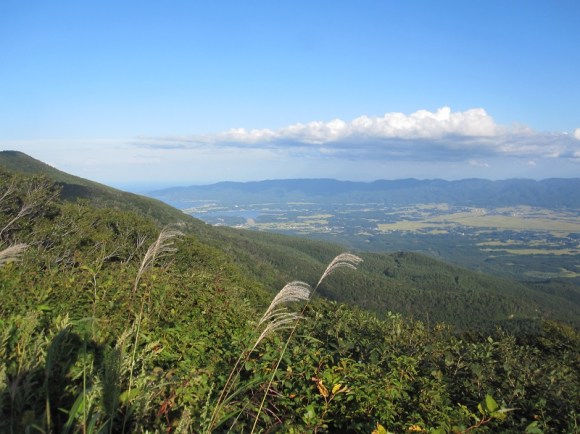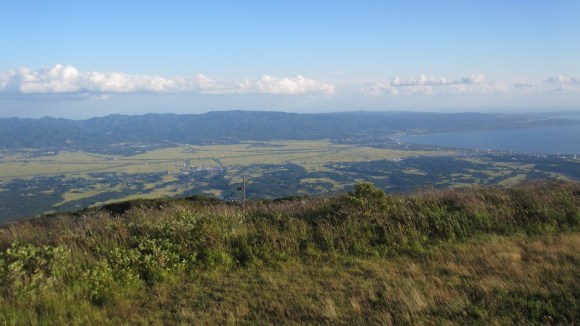
The tiny shaded part of each map represents half of the population.
Is Japan crowded? The answer really depends on where you go. On the one hand, Japan is the nation of comically packed rush hour commuter trains, but it’s also where you’ll find views like these.
Different parts of Japan have vastly different population densities, something that’s a result of both geographical and historical factors. The country’s mountainous topography has always limited where towns can be built, and during Japan’s protracted feudal era, restrictions on the flow of goods and people meant that resources clustered around the local warlord’s stronghold. Many of Japan’s present-day urban centers, including Tokyo, Osaka, Nagoya, and Hiroshima can trace their lineage back to a period of being a castle town, and even in the post-samurai age, they represent the greatest abundance of economic and educational opportunities.
To illustrate just how concentrated Japan’s population distribution is, Twitter users have taken to creating infographics that show a prefecture filled in with two colors, each representing half of the area’s residents. For example, Chiba Prefecture, Tokyo’s neighbor to the east, is home to some 6.2 million people, but half of them live just a stone’s throw away from the nation’s capital, in the area marked in red on the map below.
千葉県の人口2分割です pic.twitter.com/Wa254X585F
— みながれ (@Mina_akagi) November 25, 2016
North of Tokyo, you’ll find a pretty similar situation in Saitama Prefecture.
埼玉県を同じ人口で二分割するとこうなる
— LaTeX Glaceon(ラテグレ) (@latex_glaceon) November 25, 2016
っていうか、しゅうちゅうしすぎて、3分割になる pic.twitter.com/q5CGf676qT
Heading over to central Japan, Nara Prefecture has plenty of cool places to visit. Just about everyone wants to live at the north tip, though, in the prefectural capital of Nara City, which is linked by quick rail access to Osaka and Kyoto.
奈良県を、人口が(だいたい)等しくなるように2つに分割してみた pic.twitter.com/erX1EaYu7G
— らび (@ibaruyan) November 25, 2016
Another Osaka neighbor, Wakayama Prefecture, also has everyone wanting to find homes as close as possible to the border with the Kansai region’s largest city, located to Wakayama’s north.
https://twitter.com/ruta_q/status/802003291622080513Gifu Prefecture is seeing a huge influx of visitors coming to see the setting of some of anime hit Your Name’s most pivotal scenes, but most of the people who live there want to be situated close to Nagoya, across the prefectural line to the south in Aichi Prefecture.
https://twitter.com/ruta_q/status/802012993131155456Sometimes, though, a prefecture’s population gathers in its middle, like in Miyagi Prefecture, where capital city Sendai and neighboring municipality Natori together claim 50 percent of the prefectural population.
奈良県の人口2分割が話題になってるけど宮城県も大概だと思う pic.twitter.com/Gf25oXoL4X
— つくも (@kogasaLv96) November 25, 2016
And how does everything look when we zoom out to the national level? In the illustration below, those tiny blue areas represent half of Japan’s populace, with the scattered dark red spots accounting for an additional 25 percent, and the remaining quarter of the country’s residents spread out over the pink zones.
なんか人口二分割が流行ってるみたいなので全国版でやってみた。日本では青い部分に人口の半分が住んでいます。青い部分と濃い赤部分を合わせると人口の75%が住んでいます。青い面積は合わせると岩手県よりちょい広いくらいです。人口の集中っぷりが顕著ですね。 pic.twitter.com/dGMjn5tYwL
— Simon_Sin (@Simon_Sin) November 26, 2016
So really, most of Japan isn’t very crowded at all, as there are several points on the map where you’d have hardly any close neighbors at all. If you want to be near one of the big cities, though, well, let’s just say we hope you’re a people person, because you’re going to be dealing with a lot of them every day.
Source: IT Media, Twitter/@Simon_Sin
Top, insert image ©RocketNews24
Follow Casey on Twitter, where he feels like the population density in his part of Yokohama is just right.


 Temple camping in Japan at Wakayama’s Daitaiji【Photos】
Temple camping in Japan at Wakayama’s Daitaiji【Photos】 Plum crazy Wakayama’s local take on Tabasco sauce is made with Japanese plums
Plum crazy Wakayama’s local take on Tabasco sauce is made with Japanese plums Daiso releases shoulder bag series for every prefecture in Japan with surprising trivia facts
Daiso releases shoulder bag series for every prefecture in Japan with surprising trivia facts Amazing time-lapse-style video shows 150-year history of the growth of train stations in Japan
Amazing time-lapse-style video shows 150-year history of the growth of train stations in Japan When do Japanese women have their first kiss? Survey finds gap between different parts of Japan
When do Japanese women have their first kiss? Survey finds gap between different parts of Japan Japan’s new difficult-to-drink-from beer glass protects your liver, but it’s a brutal experience
Japan’s new difficult-to-drink-from beer glass protects your liver, but it’s a brutal experience Demon Slayer: Kimetsu no Yaiba gets new roller coaster attractions and food at Universal Studios Japan
Demon Slayer: Kimetsu no Yaiba gets new roller coaster attractions and food at Universal Studios Japan Come play hide-and-seek on a deserted Japanese island this August and November
Come play hide-and-seek on a deserted Japanese island this August and November New Pokémon ice cream, dessert drinks, and cool merch coming to Baskin-Robbins Japan【Pics】
New Pokémon ice cream, dessert drinks, and cool merch coming to Baskin-Robbins Japan【Pics】 Infographic shows how working culture differs across the globe
Infographic shows how working culture differs across the globe New Nintendo Lego kit is a beautiful piece of moving pixel art of Mario and Yoshi【Photos】
New Nintendo Lego kit is a beautiful piece of moving pixel art of Mario and Yoshi【Photos】 Real Buddhist monk plays Super Mario Bros., recites prayers every time he kills an enemy【Video】
Real Buddhist monk plays Super Mario Bros., recites prayers every time he kills an enemy【Video】 We check out the local flavors of the commonly confused Ome and Aomi areas of Tokyo in one day
We check out the local flavors of the commonly confused Ome and Aomi areas of Tokyo in one day Restaurant Yoshibei is crazy in the best way: A pork cutlet set with a side of pork cutlet bowl
Restaurant Yoshibei is crazy in the best way: A pork cutlet set with a side of pork cutlet bowl W.T.F. Japan: Top 5 craziest Japanese certification exams 【Weird Top Five】
W.T.F. Japan: Top 5 craziest Japanese certification exams 【Weird Top Five】 Nintendo history you can feel – Super NES, N64, and GameCube controllers become capsule toys
Nintendo history you can feel – Super NES, N64, and GameCube controllers become capsule toys Hello, cosmetics! Clinique teams up with Hello Kitty this summer for first-time collaboration
Hello, cosmetics! Clinique teams up with Hello Kitty this summer for first-time collaboration “The most Delicious Cup Noodle in history” – Japan’s French Cup Noodle wins our heart【Taste test】
“The most Delicious Cup Noodle in history” – Japan’s French Cup Noodle wins our heart【Taste test】 Starbucks releases a cute Frappuccino and Unicorn Cake…but not in Japan
Starbucks releases a cute Frappuccino and Unicorn Cake…but not in Japan Kyoto Tower mascot termination reveals dark side behind cute Japanese characters
Kyoto Tower mascot termination reveals dark side behind cute Japanese characters McDonald’s Japan’s Soft Twist Tower: A phantom ice cream only sold at select branches
McDonald’s Japan’s Soft Twist Tower: A phantom ice cream only sold at select branches Yabai Ramen: What makes this Japanese ramen so dangerous?
Yabai Ramen: What makes this Japanese ramen so dangerous? Finally! Nintendo Japan expands Switch 8-bit controller sales to everybody, Online member or not
Finally! Nintendo Japan expands Switch 8-bit controller sales to everybody, Online member or not Japanese government wants to build luxury resorts in all national parks for foreign tourists
Japanese government wants to build luxury resorts in all national parks for foreign tourists To combat declining birth rate, Japan to begin offering “Breeding Visas” to foreigners
To combat declining birth rate, Japan to begin offering “Breeding Visas” to foreigners 10 things you should buy at 7-Eleven in Japan
10 things you should buy at 7-Eleven in Japan Studio Ghibli releases anime heroine cosplay dresses that are super comfy to wear
Studio Ghibli releases anime heroine cosplay dresses that are super comfy to wear Woman charged for driving suitcase without a license in Osaka
Woman charged for driving suitcase without a license in Osaka Studio Ghibli unveils My Neighbour Totoro miniature house model
Studio Ghibli unveils My Neighbour Totoro miniature house model Kyoto experiencing problems with foreign tourists not paying for bus fares, but not on purpose
Kyoto experiencing problems with foreign tourists not paying for bus fares, but not on purpose Fighting mild hunger with a Japanese soda that turns into jelly in the stomach【Taste test】
Fighting mild hunger with a Japanese soda that turns into jelly in the stomach【Taste test】 Studio Ghibli’s Howl’s Moving Castle tapestry unveiled in Japan for first time
Studio Ghibli’s Howl’s Moving Castle tapestry unveiled in Japan for first time McDonald’s new Happy Meals offer up cute and practical Sanrio lifestyle goods
McDonald’s new Happy Meals offer up cute and practical Sanrio lifestyle goods Sales of Japan’s most convenient train ticket/shopping payment cards suspended indefinitely
Sales of Japan’s most convenient train ticket/shopping payment cards suspended indefinitely Sold-out Studio Ghibli desktop humidifiers are back so Totoro can help you through the dry season
Sold-out Studio Ghibli desktop humidifiers are back so Totoro can help you through the dry season Japanese government to make first change to romanization spelling rules since the 1950s
Japanese government to make first change to romanization spelling rules since the 1950s Foreigner’s request for help in Tokyo makes us sad for the state of society
Foreigner’s request for help in Tokyo makes us sad for the state of society Ghibli founders Toshio Suzuki and Hayao Miyazaki contribute to Japanese whisky Totoro label design
Ghibli founders Toshio Suzuki and Hayao Miyazaki contribute to Japanese whisky Totoro label design Doraemon found buried at sea as scene from 1993 anime becomes real life【Photos】
Doraemon found buried at sea as scene from 1993 anime becomes real life【Photos】 Tokyo’s most famous Starbucks is closed
Tokyo’s most famous Starbucks is closed Princesses, fruits, and blacksmiths: Study reveals the 30 most unusual family names in Japan
Princesses, fruits, and blacksmiths: Study reveals the 30 most unusual family names in Japan Japan’s Japanese population dropping in every part of the country, foreign population rising
Japan’s Japanese population dropping in every part of the country, foreign population rising Daily horde of commuters into Tokyo is larger than one of history’s fiercest conquering armies
Daily horde of commuters into Tokyo is larger than one of history’s fiercest conquering armies Prefectural capital building in Japan has a moat, ready for mobs of invaders or zombies
Prefectural capital building in Japan has a moat, ready for mobs of invaders or zombies Do you dress like Tokyo or Osaka? Study creates one outfit for every Japanese prefecture
Do you dress like Tokyo or Osaka? Study creates one outfit for every Japanese prefecture Online “Population Decrease Map” of Japan paints a bleak, womanless future for the country
Online “Population Decrease Map” of Japan paints a bleak, womanless future for the country Japanese government wants to build luxury resorts in all national parks for foreign tourists
Japanese government wants to build luxury resorts in all national parks for foreign tourists Thinking about moving to Nara? Here are eight things that may surprise you!
Thinking about moving to Nara? Here are eight things that may surprise you! Wakayama’s “Umi no Sachi” train line adds a colorful splash to the start of summer
Wakayama’s “Umi no Sachi” train line adds a colorful splash to the start of summer Japan’s favorite Pokémon types by prefecture–which types are the most popular?
Japan’s favorite Pokémon types by prefecture–which types are the most popular? Magazine survey picks Japan’s 10 best towns to live in
Magazine survey picks Japan’s 10 best towns to live in Depopulation in Japan leads company to renovate two apartments into one huge living space
Depopulation in Japan leads company to renovate two apartments into one huge living space New hemp mascot character Asamiko-chan appears in Japan
New hemp mascot character Asamiko-chan appears in Japan Japan’s suicide number drops for eighth straight year, rises among teens
Japan’s suicide number drops for eighth straight year, rises among teens Smooching survey: Finding out what age Japanese women had their first kiss
Smooching survey: Finding out what age Japanese women had their first kiss Is this Japanese train crowded? Question divides the nation
Is this Japanese train crowded? Question divides the nation The Tokyo area welcomed more new foreign residents than Japanese ones last year
The Tokyo area welcomed more new foreign residents than Japanese ones last year
Leave a Reply